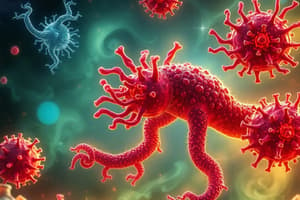Podcast
Questions and Answers
Which of the following characteristics is associated with innate immunity?
Which of the following characteristics is associated with innate immunity?
- Development of memory for faster response upon re-exposure.
- A non-specific, first-line defense that responds immediately. (correct)
- A delayed response time measured in days to weeks.
- A highly specific defense mechanism targeting particular pathogens.
How does the response to a pathogen differ between innate and acquired immunity upon re-exposure to the same pathogen?
How does the response to a pathogen differ between innate and acquired immunity upon re-exposure to the same pathogen?
- Both innate and acquired immunity develop a faster, stronger response.
- Innate immunity provides the same response each time, while acquired immunity develops a faster, stronger response. (correct)
- Both innate and acquired immunity exhibit the same response each time.
- Innate immunity provides a faster, stronger response, while acquired immunity provides the same response.
Which of the following cell types is primarily involved in acquired (adaptive) immunity but not in innate immunity?
Which of the following cell types is primarily involved in acquired (adaptive) immunity but not in innate immunity?
- Neutrophils
- T cells (correct)
- Macrophages
- Natural killer (NK) cells
What is the primary mechanism of action for acquired (adaptive) immunity in response to a pathogen?
What is the primary mechanism of action for acquired (adaptive) immunity in response to a pathogen?
Which of the following is an example of innate immunity?
Which of the following is an example of innate immunity?
What is the typical response time for acquired (adaptive) immunity?
What is the typical response time for acquired (adaptive) immunity?
Which of the following cells are involved in both innate and acquired immunity?
Which of the following cells are involved in both innate and acquired immunity?
What is the main aspect of acquired immunity?
What is the main aspect of acquired immunity?
Which of the following is an example of acquired immunity?
Which of the following is an example of acquired immunity?
What is the first line of defense?
What is the first line of defense?
Flashcards
Innate Immunity: Definition
Innate Immunity: Definition
First-line defense that is non-specific.
Innate Immunity: Response Time
Innate Immunity: Response Time
Immediate, ranging from minutes to hours.
Innate Immunity: Memory
Innate Immunity: Memory
This immunity has no memory, and reactions stay the same.
Innate Immunity: Cells Involved
Innate Immunity: Cells Involved
Signup and view all the flashcards
Acquired (Adaptive) Immunity: Definition
Acquired (Adaptive) Immunity: Definition
Signup and view all the flashcards
Acquired Immunity: Response Time
Acquired Immunity: Response Time
Signup and view all the flashcards
Acquired Immunity: Memory
Acquired Immunity: Memory
Signup and view all the flashcards
Acquired Immunity: Cells Involved
Acquired Immunity: Cells Involved
Signup and view all the flashcards
Acquired Immunity: Mechanism
Acquired Immunity: Mechanism
Signup and view all the flashcards
Innate Immunity: Mechanism
Innate Immunity: Mechanism
Signup and view all the flashcards
Study Notes
- There are two types of immunity, innate and acquired/humoral.
Innate Immunity
- This is the first-line of defense, non-specific.
- Response time is immediate, from minutes to hours.
- There is no memory; the response is the same each time.
- Macrophages, neutrophils, dendritic cells, and natural killer (NK) cells are involved.
- Mechanisms include inflammation, phagocytosis, and antimicrobial proteins (e.g., complement system).
- Examples include skin barrier, stomach acid, fever, interferons, and macrophages.
Acquired (Adaptive) Immunity
- This is the second-line of defense, highly specific.
- Response time is delayed, from days to weeks.
- Memory develops; faster stronger response upon re-exposure.
- B cells (humoral immunity) and T cells (cell-mediated immunity) are involved.
- Mechanisms include antibody production (B cells) and cytotoxic response (T cells).
- Examples include vaccination-induced immunity and immunity after infection.
Studying That Suits You
Use AI to generate personalized quizzes and flashcards to suit your learning preferences.




